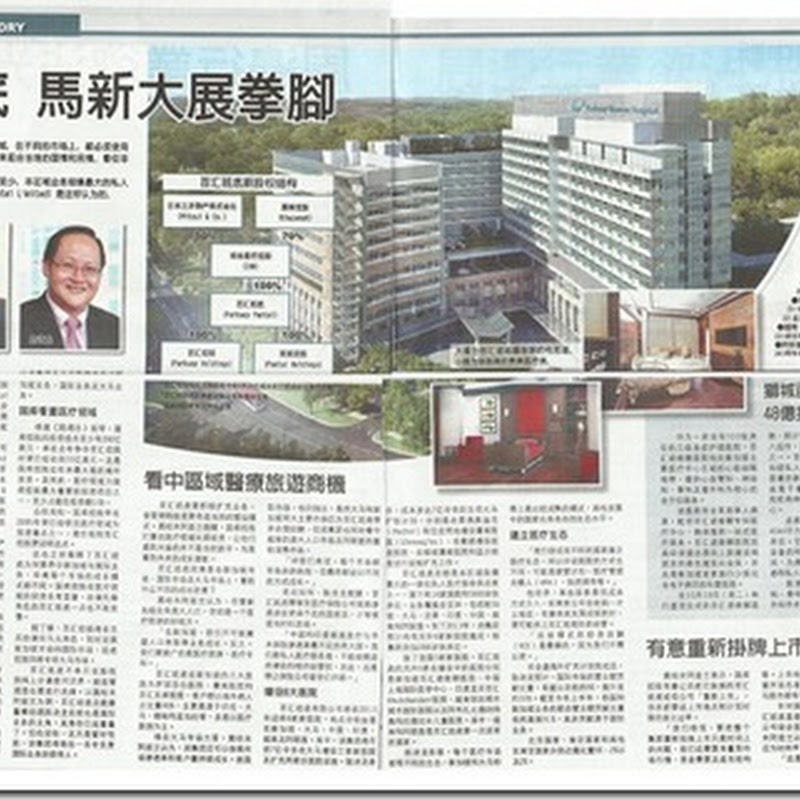Mercury Securities Sdn Bhd Research House:-
PERFORMANCE
Freight’s (FMH) latest FY10 results revealed steady revenues and profits that were within, but at the higher-end of our earlier expectations for full year FY10.
“FMH reports strong FY10 results”
FMH had recorded a strong y-o-y revenue growth of 38.7% or RM20.8 million to RM74.6 million during its 4Q/FY10 (4Q/FY09: RM53.8 million), contributed by the strong demand for seafreight and airfreight services. The group’s strong seafreight volumes (in TEUs) resulted in segment revenues that were more than 10% above our earlier expectations.
“Seafreight volumes higher than expected”
During 4Q/FY10, revenue from the group’s core business segment - Seafreight services had increased by 56.8% or RM16.8 million. Its Airfreight segment similarly enjoyed a healthy y-o-y growth of 76.7% or RM3.3 million during 4Q/FY10. Meanwhile, FMH’s support services segments such as Warehouse & Distribution, Haulage and Landfreight grew by 23.1%, 35.0% and 85.7% y-o-y respectively during 4Q/FY10.
The group’s Land Transport service which was launched in FY09 to transport loose and full-truck cargoes between Malaysia and Thailand had gained popularity among its existing customers. The expansion in demand for the group’s international freight services had provided further impetus for growth in its domestic logistics services, such as Warehouse & Distribution, Custom Brokerage and Haulage services.
During 4Q/FY10, the group’s profit before tax (PBT) had expanded by RM0.9 million or 15.6% to RM6.6 million (4Q/FY09: RM5.7 million), while the group’s net profit after tax after minority interest (NPATMI) had increased by RM0.7 million to RM4.7 million (4Q/FY09: RM4.0 million). For FY10 ending 30th June 2010, the group had recorded PBT of RM21.8 million against RM19.3 million, a growth of 12.9% y-o-y. The group achieved a growth of 21.2% in NPATMI, an increase of RM2.8 million to RM16.4 million (FY09: RM13.6 million).
OUTLOOK/CORP. UPDATES
FMH’s management remains very focused on its core business in the provision of freight services. Additionally, the group continues to seek opportunities to grow its businesses through potential acquisition within the industry both in domestic and regional markets. FMH’s freight (sea and air) volumes (TEUs) had recovered well in its FY10. The steady performance across most of FMH’s business segments in FY10 and the general improvement in both global and domestic business sentiments augurs well for FMH’s overall performance during its FY11 ending 30th June 2011.
“Bright prospects during FMH’s FY11”
In April 2010, The International Monetary Fund (IMF) stated that the global economy will grow at a faster-than-expected rate this year as it continues to rebound from the crippling financial crisis. In its World Economic Outlook report, the IMF had forecast global economic growth of 4.2% for 2010 and 4.3% for 2011.
The growth in Malaysia’s foreign trade (exports/imports), IPI (Industrial Production Index) and Manufacturing Sales in recent quarters – would augur well for FMH’s freight volumes and FY11 results. The latest available Malaysian economic data (June 2010) revealed slowing growth rates in y-o-y percentage terms but still very strong numbers nevertheless, for instance - IPI (+9.4 y-o-y), and Manufacturing Sales (+13.8% y-o-y), Exports (+17.2% y-o-y) and Imports (+30.1% y-o-y). Malaysia had reported a strong 2Q/2010 GDP growth of +8.9% while Bank Negara Malaysia (BNM) had increased its overnight policy rate (OPR) to 2.75% to stifle inflationary pressures, given that overall economic conditions have improved.
“Asia to drive global growth”
FMH’s traditional focus on intra-Asian trade, with less exposure to the US and Europe trade markets, has enabled the group to recover faster (compared to some competitors) from the lower trade volumes during the global recession last year. Furthermore, global economic growth in the next few years would be led by Asian countries, such as China and India.
During FY10, 22.7% of FMH’s revenues were derived from its overseas operations in Singapore, Australia, Indonesia and Thailand. FMH is getting a steady contribution from its newer subsidiaries in Indonesia and Thailand. FMH’s management is also exploring JV opportunities in other ASEAN countries. FMH’s low-entry-cost and asset light business model has so far proved successful in Indonesia and Thailand.
“Latest venture – Vietnam”
In March 2010, Icon Line (M) SB, a wholly owned subsidiary of FMH had entered into a MOU with Mr Dang Anh Binh to form a JV company for the purpose of starting a freight forwarding business in Vietnam. In April 2010, Icon Line had entered into a JV agreement with Mr Dang to incorporated a JV company in Ho Chi Minh City, Vietnam known as Icon Freight Services Company Ltd.
In July 2010, Icon Line (Malaysia) SB had subscribed VND255 million in Icon Freight Services Co Ltd, representing 51% of total issued and paid-up capital of Icon Freight Services Co Ltd. Thereafter, Icon Freight Services Company Ltd will be a 51% owned subsidiary of Icon Line (M) SB. Currently, FMH is working on setting-up its freight operations in Ho Chi Minh City, Vietnam.
To grow organically, FMH also continually seeks to expand its customer and agent base and to explore new destinations. Additionally, FMH has intensive marketing programmes to meet customers’ demands and also continue to provide value-added services to them. FMH’s management closely monitors its business volumes, receivables collection, industry trends and economic conditions.
Israel Bombs Iran In Retaliation – But Here’s Why Iran Denies It Was
Attacked While Israel Refuses To Admit
-
Roughly a week after Iran attacked Israel with more than 300 drones and
missiles, 99% of which missed or intercepted, Israel has retaliated,
striking the...
22 hours ago














































